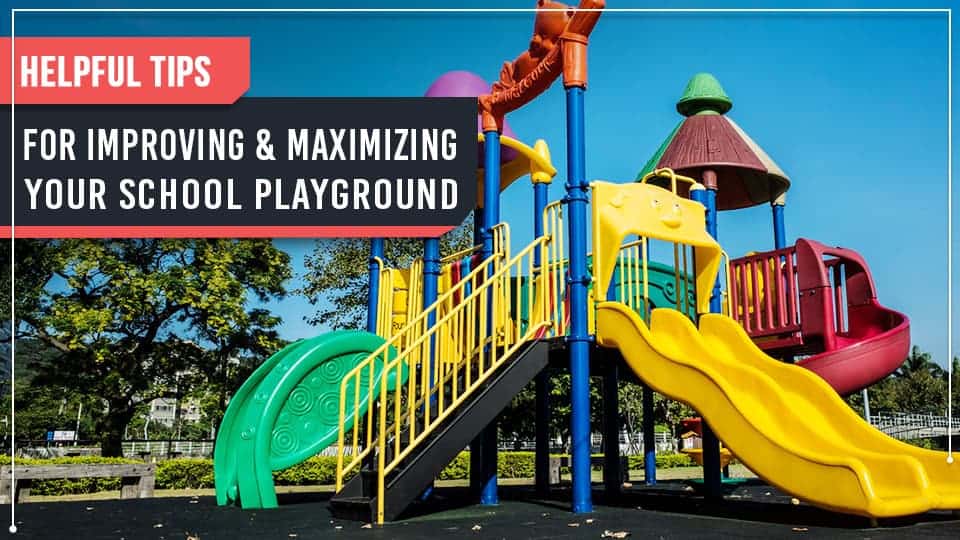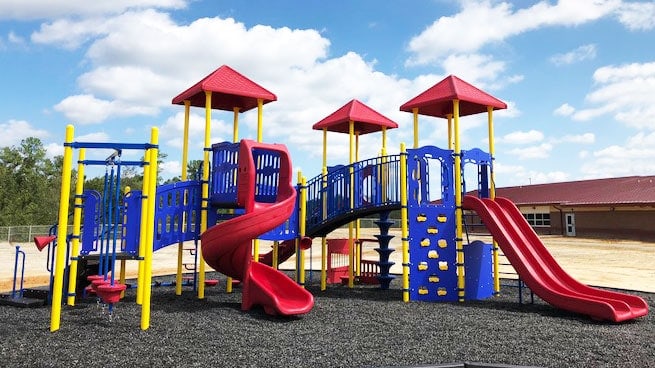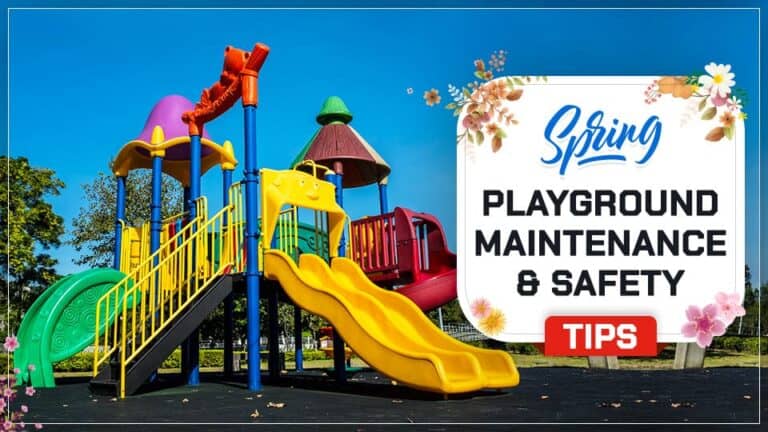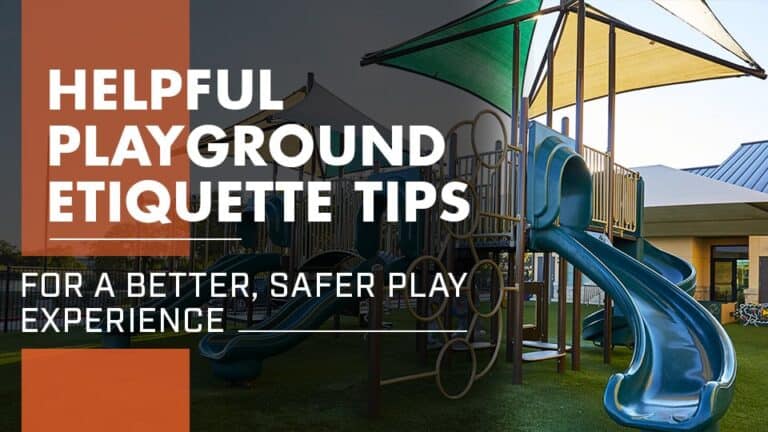Helpful Tips for Improving & Maximizing Your School Playground
Why School Playgrounds Matter
Did you know that many states have passed laws which actually require elementary schools to provide their students with daily physical activity opportunities? In addition, licensed preschools and childcare facilities are now required to provide their children with daily outdoor play opportunities, weather permitting. Legal ramifications aside, the right playground environment can play a crucial role in the growth, engagement, and development of young children. There are many documented benefits that go along with having the right commercial playground facility for your school, preschool, or childcare center. Playground equipment encourages outdoor play, helps to improve children’s physical, mental, & social skills, inspires creativity, and also offers enhanced learning opportunities for educational settings.
Questions You Should Ask in Evaluating Your Current Playground Situation
How does the playground facility you have now (assuming you have one) measure up in terms of meeting the needs of your children, your school or childcare center, and your community? And what questions should you be asking yourself to help assess your current situation? Those are really some good first questions to ask, but there are others you should bear in mind as well. Here are just a few:
1. Who’s using your playground now?
Your obvious answer here is “our students”! But which students? Are there some who shy away from playground activities? Some of that might simply be a result of individual personality differences, but there may be some deeper issues to uncover, too. Who is your playground equipment actually designed for? Who uses it actively when given the opportunity, and who doesn’t? What improvements could you make to better meet the needs of the students who aren’t participating?
2. What age or demographic does your current play area engage the least?
Go deeper with your self-discovery. Are there ages or groups of students who are less likely to be engaged by your existing playground area? For example, are your monkey bars too high for kindergartners to be able to access and use safely? Or are they perhaps too low for older elementary children to be able to enjoy?
3. How can you make your playground more accessible for a larger population?
Don’t just look at age groups; look closer at ability levels, too. Not every child who’d like to use your playground has the same level of ability and fitness. Is any of your playground equipment wheelchair-friendly? And how friendly is your playground for children with other physical or developmental challenges? Every child likes to be able to enjoy some unstructured play time, and it can be both frustrating and even damaging for children who are forced to sit on the sidelines and merely watch other children having fun.
4. Is the surfacing of your play area both safe and ADA accessible?
It’s not the play equipment you need to think about; it’s also important to consider the safety surfacing foundation underneath. Are you still using basic wood chips or wood mulch around your play features? Neither are wheelchair- or walker-friendly, and neither necessarily provides the best safety performance, either. What other alternatives might you consider for playground surfacing that’s both safe and ADA accessible?
5. How can your playground better meet the basic principles of recess?
Recess is more than just a time for children to be able to enjoy some unstructured play. There are also other specific benefits which can be derived from recess, depending upon the design of your playground and your intentionality about reaping these benefits for your students. Some basic questions to ask yourself include:
• Does our playground serve to engage students on a cognitive level?
• Does our playground environment help to grow our students’ emotional and social skills?
• Are our students staying physically active, or actually becoming more physically active as a result of engaging our playground elements?
• Do our students leave the playground refreshed and refocused for returning to the classroom?
6. Does your playground feature modern equipment, and is it in line with current student interests?
There’s a lot to be said about certain playground features which are deemed to be classic, ageless favorites. But then again, there’s also playground equipment which has simply become old, worn-out, or outdated. Students who seem to be uninterested in outdoor activities may become more engaged if you choose to install modern playground equipment, which is better designed to draw them in.
7. What’s your budget for improving your current playground, or for installing a new one?
And an obvious question that all organizations have to answer is, “What’s our budget for this?” How much money do you have allocated for playground development and improvement? What’s the fixed number you can’t go over? What additions and improvements are you able to make on your budget? And if your answer is, “We really don’t have a budget for that” … then it’s high time you create a budget line for that. This would also be a great time to brainstorm some effective ways to do some fundraising for your playground project, for the ultimate benefit of the children and communities you serve.
Some Creative Tips for Giving Your Playground a Boost
Once you’ve answered the above questions for yourself and your organization, you’ll be in a much better position to either plan for a new playground installation, or to simply improve the one you’ve already got. Giving your playground a needed boost doesn’t necessarily have to break the bank, either. With a little creativity and innovation, you really can enhance your playground for the better, no matter what your budget. Here are a few helpful suggestions:
• Strategically divide your available play space
Sectioning off areas into specific “zones” for dedicated activities is a great way to maximize the use of your space, make it safer for children, and also make it easier for teachers and adults to monitor. In addition to the main central playground, playhouse, or jungle gym feature, you can also create a swing sets and slide zone, a field sport zone, a sand/water play zone, a zone for natural elements, etc.
• Add some more recreational features
If you’re not in a position to install a brand new playground, you can always choose to add a couple of new recreational elements and features to the play area you’ve already got. For example, you might consider installing a basketball goal, tetherball goal, or other relatively inexpensive feature.
• Use paint to create some outdoor game areas
Here’s a really low-cost way to create some more play space – all it requires is some paint and a hardtop or similar outdoor surface! You can draw in some permanent outlines for popular outdoor games like hopscotch, four square, tic tac toe, etc.
• Leave some “empty” space for free play
Whenever you create and divide your specific play zones, make sure to also carve out some “empty” space for unstructured free play. As much as kids enjoy having installed elements & features to enjoy, they also appreciate having some free space for creative play. For example, think of the child on Christmas morning who enjoys playing with the large cardboard box as much as they enjoy playing with the gift which came inside! The same principle applies here, too.
• Other creative uses for paint
Paint can be used for more than just drawing in some functional play features. You can also use a little paint to beautify the extended playground environment, too. For example, if there’s an adjacent blank wall, make a plan to turn it into a mural. Better still, allow your students (and their parents) to help create the artwork for your playground mural!
• Build in space for artistic expression
Speaking of art, you can create some avenues for children to express themselves artistically on the playground for very little cost. You can turn one section of an exterior wall into a weather-resistant with nothing more than a coat of chalkboard paint. You can also set up a permanent easel (or two) by installing some erasable, clear art panels.
• Add some covered seating around the perimeter
It’s also a good idea to consider the needs of your teachers, parents, and adult playground monitors by giving them someplace to sit. At a minimum, you should plan to add some benches around your playground. Better still, you can also add some shading or covering to make folks more comfortable and also help to shield them from the elements. A well-covered seating area also gives children a place to go and cool off if they become overheated or overexerted.
Carolina Recreation & Design Provides Complete Playground Solutions
And if you’re looking for a local provider who can help you to find the perfect playground set or individual play elements & features, look no further than Carolina Recreation & Design! We offer an amazing selection of commercial playground designs and structures; and all of our equipment is designed to be age-appropriate, safe, long-lasting, and FUN for children! Plus, we install everything we sell, and we can help you with everything from safety surfacing, to sun shades, to outdoor seating, essential site amenities, and much more.
Ready to turn your school, preschool, or childcare center playground vision into a reality? Give us a call today at (704) 664-1833! You can also reach out to us online by filling out this simple form. Carolina Recreation & Design has all your playground and site preparation needs covered!









